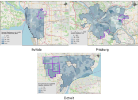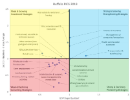Covid-19 Evictions in the Rust Belt

Published January 25, 2023
This student report analyzed the effects of the COVID-19 pandemic on the eviction rates of the Rust Belt Cities of Buffalo, Pittsburgh and Detroit. These cities were chosen by the studio specifically due to their existing conditions. Within these Rust Belt cities, there is heightened housing instability due to factors created by systemic racism. The report offers recommendations for programs and policies to prevent evictions and improve housing stability within these cities and others like them.
Methods
The students compared methods of economic analysis, spatial analysis, interviews and news media analysis, as well as document analysis to develop Pioneering, Investing, Converting, and Strengthening (PICS) development strategies and compare the relationships between industry Gross Domestic Product (GDP) and location quotients. PICS development strategies were created by analyzing two factors: SWOT (Strength, Weakness, Opportunity, and Threat) and SWGD (Strength, Weakness, Growth, and Decline). This analysis supported predictions of industry performance after the pandemic to identify areas requiring more support. The team also worked to calculate the location quotient index of the industries within each city to contribute to the PICS data.
Mapping observations and statistics for several categories informed a visual comparison of each city using industry map data from the North American Industries Classification System (NAICS). The NAICS data were found through the U.S Longitudinal Employer-Household Dynamics (LEHD) program, where the most recent data available was from 2015. Sociodemographic variables were used to map poverty rate, public housing developments, age of rental housing stock, and minority populations. These variables helped students identify census tracts that are particularly vulnerable to disasters, economic shifts, and eviction. Eviction data was analyzed by ZIP code because census tract-level data were not available for these cities.
Students also used stakeholder interviews and news media analysis to provide local context to policy discourse at a national level. These stakeholders included researchers, housing advocates and experts, as well as a former long-term Detroit resident. To close the study, students performed an overview of peer-reviewed research, policy reports and briefs, and government documents to inform their proposed policies and best practices. These recommendations supported two main categories: direct eviction prevention and housing stabilization. The recommendations could be implemented at a local level but would have a greater impact with federal funding and policy support. Direct eviction prevention strategies included extending eviction moratoria, smart rental assistance programs, housing court reform, and landlord-tenant education. Housing stabilization tactics were categorized into three main strategies of improving data collection and accessibility, targeted economic development, and increasing and improving affordable housing stock.
This studio report acknowledges the prominence of structural/ systemic racism and has used equity as a guiding principle in the process of creating our policy proposals and recommendations.
City Overviews
The cities, Buffalo, Pittsburgh and Detroit were chosen for this study because of their historical industrial reference as a Rust Belt city, as well as their comparisons with race and class segregation. Each of the selected cities is known for its own industrial legacy - Buffalo for grain, Detroit for automobile manufacturing, and Pittsburgh for steel production. These cities today account for 12 percent of the gross domestic product in the country, maintaining their importance within the global economy.
Students were intentional when observing the industry impacts on these cities since they all had specific socio-demographic differences. Buffalo has been racially segmented down the middle, Detroit is a majority-minority city, and Pittsburgh is majority white. These racial demographics were taken into consideration when understanding that each city is different and requires its own attempt to diversify the economic activity within the report to read their influence on housing evictions.
Students looked to the Rust Belt areas to understand the cultural effect that industry holds on housing and evictions. Students were able to determine that housing within the Rust Belt is among the oldest housing stock within the country. When many urban renewal projects occurred in these areas, attempts to redevelop older housing stock resulted in the relocation of long-term residents.
Findings And Recommendations
In their assessment of data, students found relevant topics through peer-reviewed sources and experts on the issues of housing, evictions, and industry. The information revealed that this particular period during the COVID-19 pandemic has only aggravated the need for affordable housing. The displacement many residents experience is also affected by inadequate transportation services, which segregate the distance between a resident’s home and work. Within the students’ research, they explored the connections of declining industry to an increase in eviction hotspots and areas with higher risk of eviction.
Students worked together to develop a series of long-term and short-term policy recommendations for the areas that are predicted to need support. To prevent direct eviction, students identified policies that would assist families in immediate need of short-term rental assistance, moratoria (the temporary postponement of an activity) for evictions as residents adjust to a post-COVID lifestyle, and providing reform to housing court processes to assist tenants in a system which favors landlords. For long-term policy recommendations, students suggested the improvement of data collection and accessibility to build awareness of consistent statistics revolving around eviction data, calling for a standardization of eviction data collection. This issue was a major hurdle for students, as they struggled to find consistent and reliable data about the current state of evictions. There was also a need for economic development strategies such as local hiring ordinances and community benefit agreements that would help areas with declining industry prevent evictions in higher risk ZIP codes. Finally, students suggested that cities like Buffalo, Detroit and Pittsburgh work with community land trusts (CLTs) which help to diversify accessible, affordable and equitable housing and development solutions and attempt to prevent displacement through development or active upkeep.
"There is no way to bring these issues to light without finding a better way to make the data more accessible." - S.M.
Students
Alison Liang, Ashley Hudson, Ausra Mussett, Evan Dash, Jackson Pavlakis, Joshua Rogers, Justyn Bellitto, Nathaniel Mich, Sarah Martin, Ted Griswold, Zachary Korosh
Faculty
JiYoung Park
Term
END 582, Spring 2021
Program
MUP





